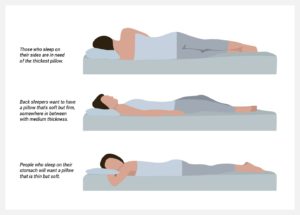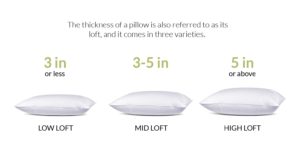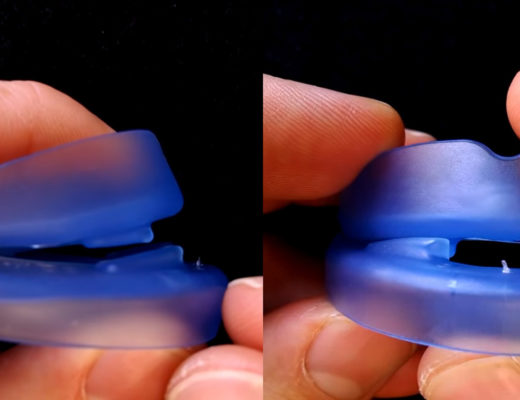Do you find yourself tossing and turning throughout the night, struggling against aches and pains in your neck and back? If your go-to solution to tuck an arm under your pillow, or to fold and stack pillows, you have a problem but may not recognize it.
The proper height pillow will serve to prop your head up and keep your neck and spine in comfortable alignment, maintaining what’s sometimes known as the neutral position. When you’re using a pillow with proper height, your body is more easily aligned, your sleep is deeper, and you’ll experience significantly less movement while getting your shut-eye.
How do you pick a pillow with the right height?
It varies for everyone, but the key points are the position you sleep in and the firmness of the pillow you’re using. There are also online calculators you can use that can offer a rough estimate of your ideal pillow’s dimensions. Regardless, the process may require some trial and error, but once you know what you’re looking for it becomes much simpler to find the right pillow height that perfectly matches your needs and will get you your best sleep.
Body Position
When you have a problem, you must first look to yourself. When you’re experiencing difficulty sleeping, this means looking at how you sleep physically. Knowing the position that you rest in will tell you how much support you need from a pillow to maintain proper alignment.
All natural sleep positions fall into three categories: back, side, and stomach. Most of us will habitually assume one position as we prepare for sleep, though it’s not uncommon for people to change sleep positions throughout the night. Once you know your sleep position, you can better determine how thick of a pillow your body needs.
If you don’t know what position you spend much of your sleep in (this isn’t as odd as it sounds; many people start in one position before their body moves into another, and will spend most of the night in the second position), you can always record yourself or ask someone else living in your household to observe you as you fall asleep.
Side Position Sleepers
 Those who sleep on their sides are in need of the thickest pillow. Regardless of how you sleep on your side (on your arm, one arm under your pillow, etc.), this position will put the greatest strain on your neck. Your head will be higher up than on your back or stomach, resulting in your neck bending down to meet the surface below it. You may also require a pillow between your legs to keep your spine straight.
Those who sleep on their sides are in need of the thickest pillow. Regardless of how you sleep on your side (on your arm, one arm under your pillow, etc.), this position will put the greatest strain on your neck. Your head will be higher up than on your back or stomach, resulting in your neck bending down to meet the surface below it. You may also require a pillow between your legs to keep your spine straight.
A taller pillow will compensate for the added height caused by lying on your shoulder. However, it needs to be firm enough to keep your neck and spine straight. Despite what you may think, a nice fluffy pillow isn’t always the best. The softer the pillow, the more likely it is to sink into itself, potentially changing the course of your spinal alignment. The pillow should cause your head to tilt forward slightly.
Back Sleepers
Back sleepers want to have a pillow that’s soft but firm, a happy cross between the two with medium thickness. The reason for this lies in the curvature of the neck itself, also known as the cervical curve. When you lie flat on your back, the cervical creates an S-like shape, which needs to be supported or else the muscles in your neck will strain to try and maintain the shape. A pillow with medium height and thickness will support your head without compromising the clavicle curve’s shape.
People who sleep on their stomach ar e unique in that they experience the least amount of distance between their head and the mattress. Their spinal alignment is easier to maintain than the other two positions. Some may not even need a pillow. Those who do, however, will want a pillow that is thin but soft.
e unique in that they experience the least amount of distance between their head and the mattress. Their spinal alignment is easier to maintain than the other two positions. Some may not even need a pillow. Those who do, however, will want a pillow that is thin but soft.
If you’re unsure of which position you sleep in, or if you don’t have a preference, a pillow that falls into the middle range of thickness is a safe bet. It compliments all but the stomach sleeping position and offers the chance for easy adjustment by folding it over or rolling it if you need more height.
Materials
The support your pillow gives is based on what material it’s made of. Softer stuffing will support your alignment less but can be more easily adjusted, whereas firmer stuffing will better maintain your alignment throughout the night. Don’t forget to consider what’s on the inside of the pillow when looking at its size.
 Foam stuffings are synthetically made and designed to hold their shape. They generally come in two forms. A standard foam will mold to the shape of your head and neck, and over time will assume that form permanently.
Foam stuffings are synthetically made and designed to hold their shape. They generally come in two forms. A standard foam will mold to the shape of your head and neck, and over time will assume that form permanently.
The second type is commonly called memory foam. Its major selling point is its reactive nature, reshaping itself as you move throughout the night. Unlike standard foam, which will breakdown over time and loses its ability to mold, memory foam has more longevity when it comes to its ability to hold form. Foam has a medium firmness.
The softest pillows are made with feathers or down. While comfortable, they have the least resistance. However, they offer more flexibility than other types of pillows because their stuffing is literally loose feathers. It can be moved around as needed to make it thinner or thicker.
Cotton pillows
 Cotton pillows are the most common pillows available, and for good reason: cotton is inexpensive and hypoallergenic. It’s also easier for manufacturers to make pillows thicker with cotton. As a stuffing, however, cotton isn’t very strong, and it becomes collapses underweight as it’s compressed. However, adjusting a cotton pillow isn’t easy, and in time will no longer have the strength to support your contours adequately.
Cotton pillows are the most common pillows available, and for good reason: cotton is inexpensive and hypoallergenic. It’s also easier for manufacturers to make pillows thicker with cotton. As a stuffing, however, cotton isn’t very strong, and it becomes collapses underweight as it’s compressed. However, adjusting a cotton pillow isn’t easy, and in time will no longer have the strength to support your contours adequately.
The firmest pillows by design are latex. They offer little give, making them a good fit for back sleepers. However, being even firmer than cotton means they are difficult to fold over or otherwise adjust. That said, they last longer than most other materials and need to be replaced less frequently.
These two factors—height and material—shouldn’t be thought of as independent. A material that’s too firm or too soft can undermine the benefits of the pillow’s height. They need to compliment each other in order to achieve the desired effect.
Trying A Pillow
Once you know what you’re looking for, you may need to shop for new a pillow. However, because we all have different needs and there are so many pillows available. There’s always a chance that your first pick won’t work out, even if it appears to meet your preferences. That’s why you should try a pillow out before buying it (if possible), test if for a few nights, and be prepared to replace it if it isn’t what you need.
 Sleep specialty stores will often provide customers with a bed they can lie down on to test a pillow out. This is the most surefire way to find a comfortable pillow, but what if you’re shopping at a place that doesn’t do this? You can’t exactly replicate your sleep position by lying against a wall or on the floor. Without being able to test it in store, you’ll simply have to wait until you get home.
Sleep specialty stores will often provide customers with a bed they can lie down on to test a pillow out. This is the most surefire way to find a comfortable pillow, but what if you’re shopping at a place that doesn’t do this? You can’t exactly replicate your sleep position by lying against a wall or on the floor. Without being able to test it in store, you’ll simply have to wait until you get home.
Likewise, internet shopping doesn’t let you give you the chance to try before you buy. Product listings may give you great descriptions that sound nice. But try reading through customer reviews to see if anyone else describes having the same sleep problems as you. Their recommendation is a strong indicator that the pillow is a good fit for you.
Once you have the pillow, though, how can you tell it works? Try not to rush things when looking for success. Even if you find that it makes things better (or even worse) on the first night. Try to give yourself five days to get a better idea of how well it will work in the long term. It’s common to feel uncomfortable for the first few nights as your body adjusts to the new pillow.
Height Calculators

Online you can find several different interactive pillow height estimators. Such tools allow you to enter certain measurements about yourself and get a recommended pillow with specific measurements and firmness. This isn’t a universal system, however, and some calculators are more specific than others. Generally, though, they will look at measurements pertaining to your head, neck, shoulders, and upper back, and some will take your sleep position into consideration.
If you’re unsure of how to begin determining what pillow height you need, height calculators can provide you with an excellent starting point. Just be aware that it isn’t a precise science and accept that you may still need to experiment.
Testing With Towels
If the above methods of testing pillows aren’t viable for you (or if you simply don’t want to deal with the potential hassle of returns), there’s a simple test you can do with towels that chiropractors use when gauging alignment problems in their clients.
Start by taking four ordinary towels and folding them three times into a square. Stack them on top of each other and rest your head against them as though they were a pillow. You’re looking for a height that won’t push your head too far forward or let it roll backward. You start with four towels because it’s almost certainly going to be too many, so once you’ve tested it unfold a layer and try again.
As you unfold layers, you’ll inch ever closer to your comfort zone. Once you’ve found your sweet spot, measure how high the stack is, and that’s roughly how high your new pillow should be. Keep in mind the principle of firmness and know that any pillow you buy will have more degree of giving than a stack of towels, even if only slightly.
Towels are used for this exercise not only because of how easy they can be adjusted but because they won’t lose their form and breakdown in the same way a pillow will. That’s why some people even swear by using towels in place of pillows. Regardless, the towel test is one of the most accurate ways to determine your measurements. But you need from a pillow to achieve alignment without having to spend a dime.
What Is Loft?
 Most product descriptions you encounter these days list measurements in both inches and centimeters. But you may find it useful to know some pillow terminology as a shortcut. The thickness of a pillow is also referred to as its loft, and it comes in three varieties.
Most product descriptions you encounter these days list measurements in both inches and centimeters. But you may find it useful to know some pillow terminology as a shortcut. The thickness of a pillow is also referred to as its loft, and it comes in three varieties.
- A low loft is usually three inches or less.
- Mid (or medium) loft is often three to five inches.
- High loft is commonly five inches or above.
However, these aren’t hard and fast rules, and different manufacturers may use different guidelines.
If you’re looking at the loft, know that lower is more firm. And it also tends to give the best support for stomach or back sleepers. High loft is ideal for side sleepers. Middle loft serves as an adjustment if you need more or less support depending on your sleep position.
In the end, there’s nothing particularly special about a pillow that includes loft in its description. It’s an easy way to eyeball a pillow’s thickness. But it doesn’t have any impact on the ability of the stuffing to maintain its form or strength.
Trial and Error
Most of us don’t think of our pillows until they start to cause us pain. Once you begin looking at all of the details of a pillow and analyze the many factors that play into how effective it is, it’s easy to feel overwhelmed. But when you understand the importance of a pillow’s height, the rest should fall into place naturally.
Remember that comfort in sleep comes from the shoulder, neck, and spinal alignment and that every part of pillow ultimately plays into its height and thickness. The value in how soft or firm it lies in how well it keeps your head elevated in relation to your neck and back. Even if you feel you have a good idea of what your needs are, always try first before you commit.






